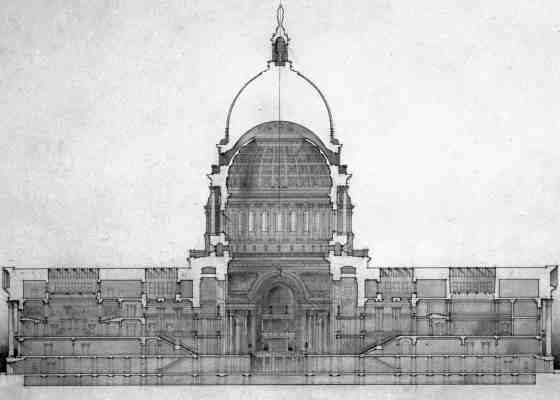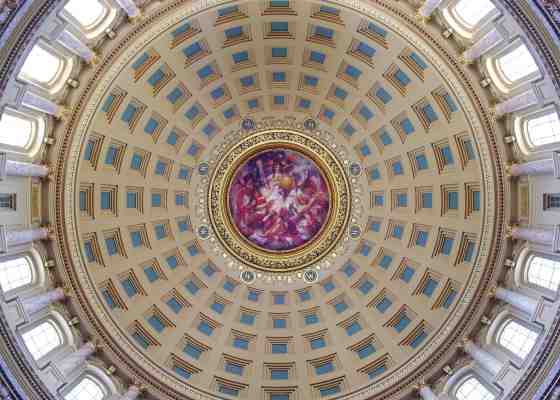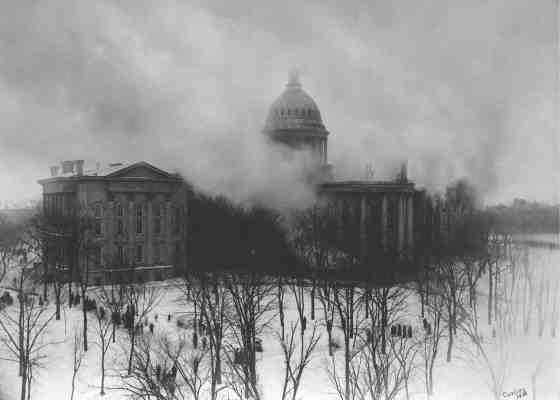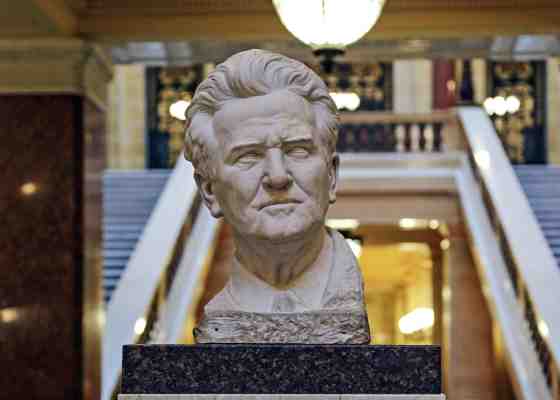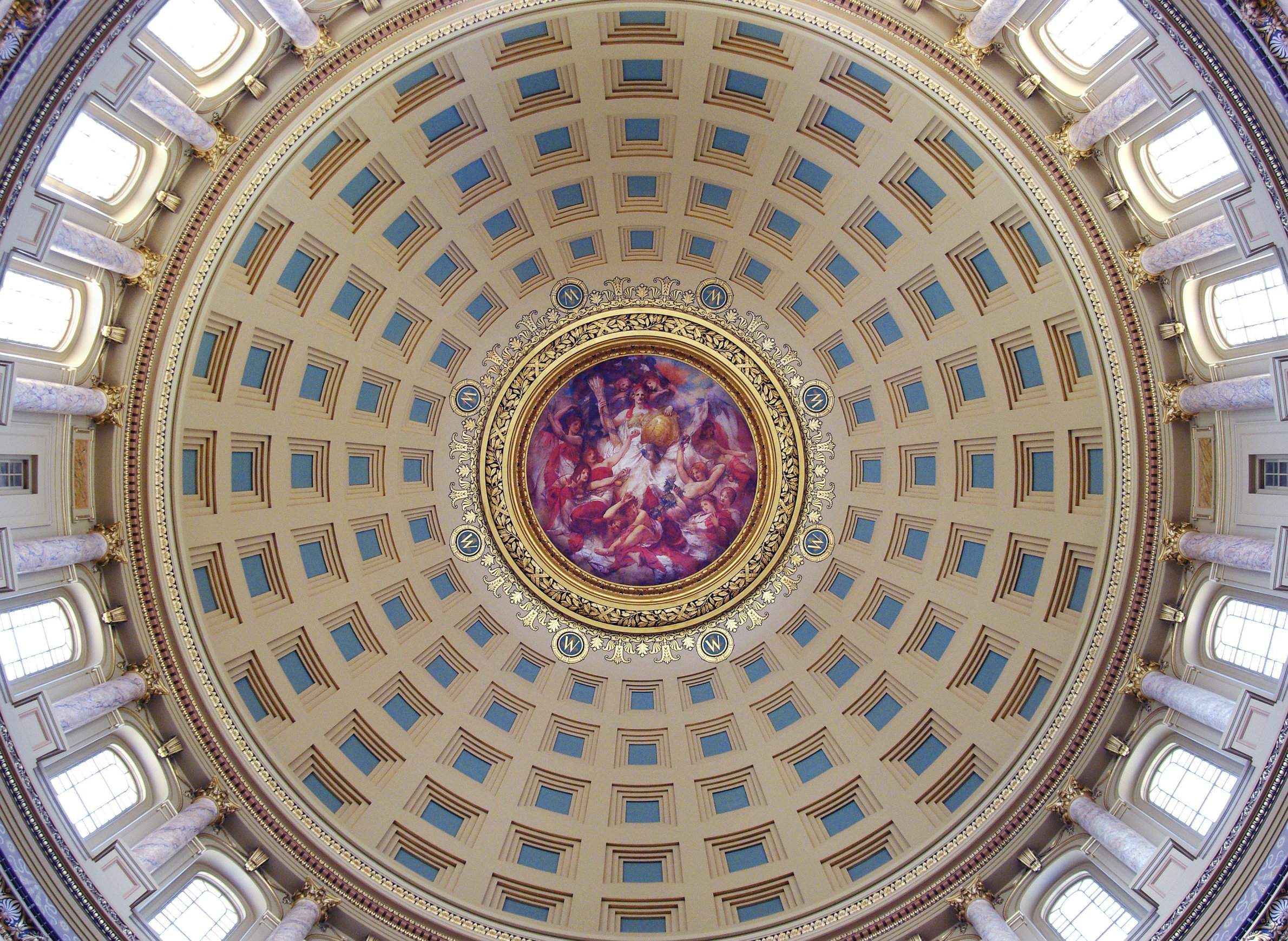
How Sculptors And Muralists Made Wisconsin's Capitol Building Complete

The World's Columbian Exposition in 1893 made renowned contributions to American amusement park attractions, cheap beer branding and serial killer lore, but it likewise provided a profound influence on the Wisconsin State Capitol.
Known as the "White City," the sprawling exposition on the south side of Chicago was an architectural and artistic showcase that epitomized American confidence at the height of the Gilded Age. Many of the nation'’s most prominent architects and artists designed buildings and statuary to populate the fairgrounds. One of these architects was George B. Post, who designed the largest building in the entire fair, the Manufactures and Liberal Arts Building. A New Yorker who pioneered the design of skyscrapers, Post was later commissioned to design a new capitol building for Wisconsin after the existing structure was seriously damaged in a fire in 1904.
The exposition's buildings were designed in the style of Beaux-Arts architecture, which was a dominant approach in the late 19th and early 20th century, particularly for public buildings around the United States. The neo-classical style is recognizable by its use of exterior masonry and elements like symmetry, columns, arched windows and lots of sculptural decorations. Post's Wisconsin Capitol Building is a prime example of that style, and its decorative elements required the work of numerous sculptors and painters.
These artistic contributions to Wisconsin's Capitol was the focus of a July 11, 2017 talk at the Wisconsin Historical Museum by retired chief state architect Dan Stephans. His presentation was recorded for Wisconsin Public Television's University Place.
"Most of the artists that worked on the Capitol had worked with the architect of the Capitol, George Post, before they came here to Wisconsin," Stephans said. Some had worked with him at the World’s Columbian Exposition, but Post had extensive art-world connections before working on the fair. Many artists who contributed to the Capitol are also known for other works of art.
Stephans discussed each artist’s contributions to the Wisconsin Capitol's statuary and murals, noting their contributions to the building and its environs.
"The artwork completes the Capitol," he said. "The symbolism of the fine art establishes principle themes and impart meaning to the building as a whole. The building, with its art, embodies the ideals of civic pride, democratic duty, and the functions of good government."
Key facts
- The Capitol's construction was completed in 1917. After many decades of use, a major renovation and renovation of the structure and its artwork was completed in January 2001. Following this work, the building was designated as a National Historic Landmark.
- Daniel Chester French designed "Wisconsin," the statue that sits atop the Capitol dome. French created two sculptures for the World's Columbian Exposition — "The Republic" and "The Triumph of Columbus" — which were considered antecedents to his design for "Wisconsin." The statue atop the Capitol is 15 feet and 4 inches tall, with a raised right hand pointing forward to signify the state's motto and a right hand holding a globe with an eagle perching atop it. Her helmet is famously crested by a badger. French's other well-known statues include "Minute Man" in Concord, Massachusetts, and the massive seated statue of Abraham Lincoln central to the Lincoln Memorial in Washington, D.C.
- Jean Miner designed "Forward," an allegorical bronze statue of a woman raising her right arm as a symbol of progress. Completed at the World's Columbian Exposition, the statue was originally placed outside the east entrance of the previous Capitol building in 1895. It was moved to a position outside the North Hamilton St. entrance of the new Capitol building in 1916 and remained in place there until 1995. After 80 years of weathering, the original statue was restored and placed inside the Wisconsin Historical Society building on the University of Wisconsin-Madison's Library Mall in 1998. Often confused with "Wisconsin," a replica was cast and placed in front of the west entrance of the Capitol facing State Street. Miner was born in Menasha and remained active in sculpting until her death at 101.
- Helen Mears designed "Genius of Wisconsin," a statue of an allegorical woman in an embrace with an eagle, sheltering her head under its outstretched wings. She originally created it in clay for the World’s Columbian Exposition, and it was later carved in marble for permanent display in Wisconsin. The statue survived the 1904 fire, and was moved to the first completed wing of the new Capitol to be displayed in the southeast round room on the first floor. A native of Oshkosh, Mears studied and worked with Beaux-Arts sculptor Augustus Saint-Gaudens, and a statue she designed of women's leader Frances Willard is on display in the National Statuary Hall Collection in Washington, D.C. Mears secured the initial contract to design a statue for the top of the Wisconsin Capitol dome, but after multiple rejections, she was dismissed and the contract given to Daniel Chester French. Her work remained an influence on his design for "Wisconsin."
- Vinnie Ream created "The West," a statue of an allegorical woman with a wind-blown gown. It was originally displayed at the World’s Columbian Exhibition, and was donated to the state of Wisconsin in 1916. It is displayed in the southwest round room on the first floor. Ream was born in Madison, where her family operated one of the first hotels in the city, before moving to Washington, D.C. at the outside of the Civil War. A year after war's end, she was the first woman sculptor and youngest artist to be commissioned by the federal government to create a statue — her resulting work was a full-size sculpture of Abraham Lincoln, on display in the U.S. Capitol Rotunda.
- Paul Fjelde designed the statue of Hans Christian Heg that faces King Street on the east corner of the Capitol Square. Unveiled on Oct. 17, 1926, less than a decade after the Capitol was completed, it commemorates the Norwegian-American colonel of a Wisconsin regiment in the Civil War who was killed at the Battle of Chickamauga in Georgia on Sept. 19, 1863.
- George Post's original design for the Capitol included several elements that were eliminated in the final structure. One was a statuary niche on each side of the end face of the building's four wings, which were replaced by plain granite masonry. Another element that was removed was four tourelles, or small towers, that were to have been placed at each intercardinal (or ordinal) location between the building's four wings. Instead, Post hired a sculptor to design statuary groups for those locations.
- Karl Bitter designed the four statuary groups that are placed atop the Capitol's central structure at each intercardinal location. Each group consists of three figures, with the central statue standing about 12 feet high and the flanking statues about half as tall. The northwest group (facing Wisconsin Ave.) represents prosperity and abundance, the northeast group (East Washington Ave.) represents knowledge, the southeast group (Martin Luther King Jr. Blvd.) represents faith, and the southwest group (West Washington Ave.) represents strength. He also designed the sculptures on the east and west pediments to the Capitol, facing King and State streets, respectively. Law is the subject of the statuary on the east pediment, befitting that wing's housing the governor's office and Supreme Court chambers. The resources of the state is the subject of the figures on the west pediment, which is on the wing that hosts the Assembly chambers. Bitter was born in Austria, and worked with George Post at the World's Columbian Exposition.
- Adolph A. Weinman designed the sculptures on the south pediment to the Capitol, facing South Hamilton Street. This wing houses the Senate chambers, and the design of this statuary reflects the concept of wisdom. Weinman was born in Germany, studied under Augustus Saint-Gaudens and worked as an assistant to Daniel Chester French. He also designed the Winged Mercury head dime and Walking Liberty half dollar, as well as the seated Abraham Lincoln statue placed near the president's birthplace in Kentucky, a replica of which is on Bascom Hill on the UW-Madison campus.
- Attilio Piccirilli designed the sculptures on the north pediment to the Capitol, facing North Hamilton Street. This set of statuary represents attributes of civilization, centered on enlightenment and wisdom. A sculptor and stone cutter, Piccirilli was born in Italy, and is best known for carving the seated statue of Abraham Lincoln at the Lincoln Memorial in Washington, D.C., which was originally designed by Daniel Chester French.
- Kenyon Cox created the four mosaics inside the Wisconsin Capitol rotunda, as well as the Senate chamber murals. Each mosaic is located at a pendentive, which is the structural feature in a building that transitions between a round dome and square building. The mosaics represent the three branches of government and the people who empower them — "Legislation," "Government," "Justice" and "Liberty," respectively. Each mosaic is about 12 feet high and 24 feet wide, and individually includes about 100,000 pieces of glass. Cox's murals for the Senate chamber symbolize the opening of the Panama Canal and the joining of the Atlantic and Pacific worlds. Cox studied at the École des Beaux-Arts in Paris, worked with George Post at the World's Columbian Exposition, and created work for other public buildings, including the state capitols of Iowa and Minnesota.
- Edwin Blashfield created the painting that appears in the Capitol rotunda oculus, as well as the Assembly chamber mural. The circular oculus painting is 34 feet in diameter, and is framed by a 27-foot diameter balcony handrail to provide a focus for viewers gazing up from the floor of the rotunda. Its subject is the resources of Wisconsin, with a central figure draped in an American flag and holding a scepter of wheat surrounded by companions holding other state products: lead, copper, tobacco, fruit and a freshwater pearl. Blashfield's mural for the Assembly chamber is titled "Wisconsin: Past, Present, and Future," and portrays stylized figures from Wisconsin history (including Native Americans, French explorers and Civil War soldiers). Blashfield worked with George Post at the World's Columbian Exposition, creating paintings for the Manufactures and Liberal Arts Building.
- Francis Millet was the director of decorations for the World's Columbian Exposition. He designed murals for the Wisconsin Supreme Court hearing room, but both the artist and his sketches were lost in the sinking of the Titanic.
- Albert Herter was hired after Millet's death to create murals for the state Supreme Court hearing room. One mural portrays a fictionalized scene of the Founding Fathers signing the U.S. Constitution, another features the signing of the Magna Carta (and includes an image of Herter's son, who would go on to be U.S. Secretary of State under President Dwight Eisenhower), and a third features Caesar Augustus in imperial Rome. A fourth mural portrays the 1830 murder trial of Chief Oshkosh, a leader of the Menominee nation of Native Americans, when Wisconsin was still a part of Michigan Territory. Chief Oshkosh was acquitted by James Doty, a later territorial governor and U.S. Representative, in a case that hinged on the intersection between American Indian and U.S. legal traditions.
- Charles Turner created the murals appearing in the Capitol's North Hearing Room, which served as the home for the state Railroad Commission. Therefore, the paintings in the room's ceiling coves featuring different methods of transportation in the state up to 1917, from horseback to canoe to stagecoach to a 20th century assemblage of mechanized vehicles. Turner worked under Francis Millet as the assistant director of decorations for the World's Columbian Exposition.
- Hugo Ballin created the 26 murals that are in the governor's conference room, located in the Capitol’s east wing. The room's design is inspired by the Doge's Palace in Venice, with the paintings featuring allegorical attributes of the state, the previous Capitol buildings, and scenes from Wisconsin history, including the landfall by Jean Nicolet near the future site of Green Bay in 1634 and the surrender of Ho-Chunk leader Red Bird in 1827 that ended the Winnebago War, along with others featuring figures like Civil War nurse Cordelia Harvey and naturalist Increase Lapham. Ballin went on to work in Hollywood, and produced silent films with his own production company, including Jane Eyre (1921) and Vanity Fair (1923).
Key quotes
- On the purpose of art in the Wisconsin Capitol: "Many of the pieces of sculpture, the mosaics, and the murals are thoroughly integrated in the architecture of the building. They could stand alone as art, but they are building components."
- On how a contract to design a statue to top the Capitol dome was switched from Helen Mears to Daniel Chester French: "In December 1910, Mears was given a contract to create a statue to be placed on top of the Wisconsin Capitol. She began designing models, and her models were severely criticized by the Capitol Commission, and she worked to revise, rebuild models, tried to get them approved. She created a third model that [George] Post did not submit for review when the commission asked for other sculptors to submit their proposals. In June 1911, the commission suspended her contract and gave the contract to Daniel Chester French. Mears consulted with French just prior to his selection about technical matters regarding the enlargement of her third model."
- On how Daniel Chester French considered a ground-level viewer's perspective while designing "Wisconsin" in New York: "French built a temporary studio on the cliffs of the Hudson River where some 200 feet above the valley floor he worked and modeled his figure so that he might judge its proportion and attitude from appropriate distance below."
- On Adolph Weinman's role in creating one of Madison’s other famous statues: "In 1905, Richard Lloyd Jones — that would be Frank Lloyd Wright's cousin — purchased the farm where Lincoln was born. He commissioned Weinman to do a statue of Abraham Lincoln. Many of the contributors financed that statue, including President Lincoln's only surviving son Robert. A replica of Weinman's Lincoln statue was unveiled in the middle of Bascom Hill between North and South Halls in 1909. That was 100 years after Lincoln's birth. Bascom Hill's Lincoln was moved to its current location after 10 years of standing as 'like a mushroom sticking out of the sod.' That was according to a 1917 On Wisconsin magazine article."
- On how a badger was added to Edwin Blashfield's mural in the Assembly chambers: "[W]hen the mural was done and Blashfield was asked to describe it, he wrote: 'Since the painting was placed on the wall, a badger has crept in and made himself at home.' When [George] Post saw the finished mural, he saw that it lacked a badger and instructed Blashfield to put a badger in. So a soldier sitting on the rock was painted out, the badger was painted in, and today the nature of oil paintings allows you to see a ghost of a soldier coming back."
- On how the sinking of the Titanic affected the design of the Supreme Court chambers beyond the loss of Francis Millet: "When the Titanic went down, it also took with it some doubled bookmatch marble that was to replace some rejected marble in the Supreme Court hearing room, which, if you go in there, you can find it. It's the only panel that's not double bookmatched. And if you don't know what that means, that's splitting it twice so that it looks like a mirror image in two directions."



